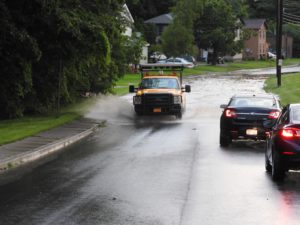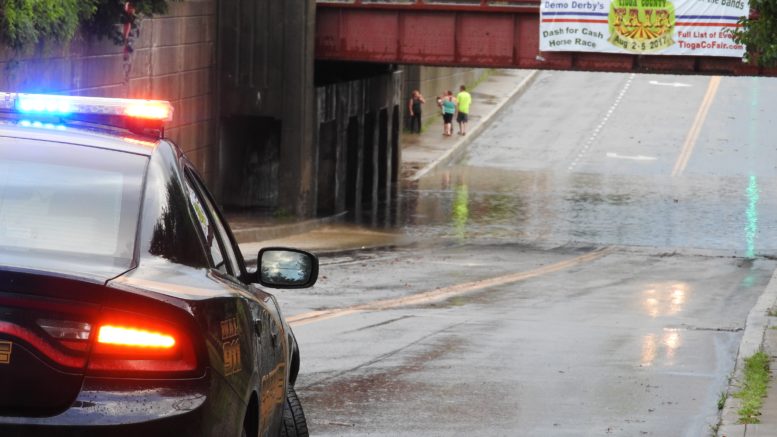
Vehicles struggle their way through flooded streets in Owego on Monday afternoon. (Photo by Wendy Post)
Governor Andrew M. Cuomo today deployed commissioners and executive and regional staff from the Governor’s Office, Department of Transportation, and Division of Homeland Security and Emergency Services to assess damage after heavy rains and flooding occurred in Tioga and Broome Counties overnight.
State Route 17 is closed between Exit 62 (Nichols) and Exit 63 (Lounsberry) in Tioga County due to damage from Sunday night’s flash flooding and detours have been posted. State Police are assisting with traffic control and traveler advisories, and electronic variable message signs in New York and Pennsylvania are being used to warn motorists of the closure.
“Flooding and other severe weather have damaged roads and bridges across the Southern Tier and continues to cause issues in urban areas, where drainage is poor, and near rivers and streams which are already at their peak levels,” Governor Cuomo said. “We are deploying state resources to provide assistance to New Yorkers in need and help these communities recover as quickly as possible.”

One local resident got out the kayak after the rain stopped. Pictured, is Michelle Anders and her son, Mason.
The New York State Department of Transportation has mobilized 39 staff in response to last night’s flash flooding, including two bridge inspection teams checking for structural damage to bridges, two engineers and 31 highway maintenance staff. DOT deployed equipment to remove debris, perform ditch repair and other highway maintenance activities. DOT is also expediting repairs to the Route 17 Bridge over Wappasening Creek in the Town of Nichols, which rose 10 feet very quickly overnight and exposed support pilings due to a washout of the embankment.
Equipment deployed includes 11 dump trucks, five pickup trucks, three loaders, a backhoe, a bobcat, two excavators and a tractor trailer. The Department also has executed a contract that will expedite bridge repairs, enabling traffic to be restored as soon as possible. For up to date travel conditions, including road closures, dial 511 or visit www.511ny.org.
The Division of Homeland Security and Emergency Services Office of Emergency Management has been in constant communication with local officials and emergency management have four personnel in the area. State Stockpiles have been readied for deployment and the following assets are available if needed:
• 61 generators in the Binghamton Stockpile, and 608 available statewide
• 32 light towers in the Binghamton Stockpile, and 232 available statewide
• 5 pumps in the Binghamton Stockpile, and 1,218 available statewide
• 30,000 sandbags in the Binghamton Stockpile, and 482,680 available statewide
While the very heaviest of the rain has passed through the area, parts of Broome and Tioga Counties have already received two to four inches or more of rain which resulted in flash flooding with more flooding expected due to the potential for an additional inch of rain in a short period of time especially in poor drainage areas in and around urban locations, and the sensitive areas that have recently received heavy rain and already experienced flooding. The National Weather Service has issued a Flash Flood Watch for Broome and Tioga Counties until 8 p.m. tonight.
The State Watch Center and Emergency Operations Center are operating at a Level 4 activation which includes enhanced monitoring as the Flood Watches and Warnings continue throughout the day
More than 12 Department of Environmental Conservation Environmental Conservation Officers, Spills Response and Division of Water staff are inspecting flood control projects in Broome, Tioga, and Chenango counties. Inspections to date have not identified any issues. On July 24, DEC Environmental Conservation Officers patrolled the Big Choconut Creek in Vestal in response to flooding and to determine if additional resources might be required. Initial reports indicate the Susquehanna River and associated flood control facilities have not been adversely affected, but localized heavy rains south of the Susquehanna caused flash flooding in some streams in the watershed. Damage assessments are continuing.
DEC Environmental Conservation Officers, Spills Response and Division of Water staff will continue to assess flood impacts in the Southern Tier counties.
The Governor offered the following tips to stay safe from flooding:
Download NY-Alert
NY-Alert is the state’s free, subscription based, customizable, all-hazards alerting system. Alerts, such as important information regarding severe weather, can be emailed and also pushed to your cell phone via text message. To subscribe, visit the NY-Alert website at https://www.nyalert.gov/. For more information on NY-Alert, visit the FAQ page at https://www.nyalert.gov/faq.
If Flooding Occurs in Your Area:
- Monitor the National Oceanic & Atmospheric Administration’s (NOAA) Weather Radio or your local radio and TV station broadcasts for information.
- If local officials advise evacuation, do so promptly.
- If directed to a specific location, go there.
- Know where the shelters are located.
- Bring outside possessions inside the house or tie them down securely. This includes lawn furniture, garbage cans, and other movable objects.
- If there is time, move essential items and furniture to upper floors in the house. Disconnect electrical appliances that cannot be moved. DO NOT touch them if you are wet or standing in water.
- If you are told to shut off water, gas, or electrical services before leaving, do so.
- Secure your home: lock all doors and windows.
If You Have Experienced Flooding in Your Home or Business:
- Walls, hard-surfaced floors and many other household surfaces must be cleaned with soap and water and disinfected with a solution of 1 cup of bleach to five gallons of water.
- Thoroughly disinfect surfaces that come in contact with food and children’s play areas.
- Wash all linens and clothing in hot water or dry-clean.
- Items that cannot be washed or dry-cleaned, such as mattresses and upholstered furniture, must be air dried in the sun and sprayed thoroughly with a disinfectant.
- Steam-clean all carpeting.
- Replace fiberboard, insulation and disposable filters in your heating/cooling system.
If You Must Travel:
- Do not attempt to drive over flooded roads turn around and go another way. Water moving at two miles per hour can sweep cars off a road or bridge.
- Watch for areas where rivers or streams may suddenly rise and flood, such as highway dips, bridges, and low areas.
- If you are in your car and water begins to rise rapidly around you, abandon the vehicle immediately.
If You Lose Power
- Call your utility first to determine area repair schedules. Turn off or unplug lights and appliances to prevent a circuit overload when service is restored. Leave one light on to indicate power has been restored
- Keep refrigerator and freezer doors closed as much as possible to help reduce food spoilage.
- If you have space in your refrigerator or freezer, fill plastic containers with water, leaving an inch of space inside each one. This will help keep food cold.
If You Need to Use a Generator:
- Before installing a generator, be sure to properly disconnect from your utility electrical service. If possible, have your generator installed by a qualified electrician.
- Run generators outside, downwind of structures. Never run a generator indoors. Deadly carbon monoxide gas from the generator’s exhaust can spread throughout enclosed spaces.
- Fuel spilled on a hot generator can cause an explosion. If your generator has a detachable fuel tank remove it before refilling. If this is not possible, shut off the generator and let it cool before refilling.
- Do not exceed the rated capacity of your generator. Most small, home-use portable generators produce 350 to 12,000 watts of power. Overloading your generator can damage it and appliances connected to it, and may cause a fire. Follow the manufacturer’s instructions.
- Keep children away from generators at all times.
Avoid Carbon Monoxide Poisoning:
- Do not operate generators indoors; the motor emits deadly carbon monoxide gas.
- Do not use charcoal to cook indoors. It, too, can cause a buildup of carbon monoxide gas.
- Do not use your gas oven to heat your home — prolonged use of an open oven in a closed house can create carbon monoxide gas.
- Install a carbon monoxide alarm.
For more safety information, visit the Division of Homeland Security and Emergency Services website at: http://www.dhses.ny.gov/



Be the first to comment on "Governor deploys staff to Southern Tier to survey areas hit by flash flooding; watch continues"